According to MarketingSherpa, a part of the MECLABS Institute family of research companies, companies lose approximately 25% of their active email list every year. In addition to unsubscribers, the 25% also includes consumers who are so disengaged with a brand that they stop opening emails and making purchases.
Table of Contents
1. Mobile-Friendly Emails
- According to a recent study by Constant Contact, approximately 61% of all marketing emails are opened on a mobile device, an increase from 42% in 2014 and 27% in 2012. These figures prove how preference for mobile-friendly emails has increased over time. As a result, SuperOffice reported that customers are most likely to delete an email or unsubscribe when they receive emails that are not mobile-friendly.
- EmailMonday also reported that during 2019’s first quarter, mobile clients accounted for 41.9% of email opens compared to 18.2% desktop opens. Moreover, around 3 in every 5 customers check their emails while on the go through their mobile phones, while approximately 75% stated that they often use their smartphones to check their emails. An adobe report also found out that smartphones are the most common gadgets used to check emails regularly at 81%.

- Statistics also reveal that when email campaigns are mobile-optimized, companies stand a chance to increase their chances to generate more revenue as the “average revenue per mobile email is $0.40, which is more than 4x that of a desktop email click.”
2. Ask for Specific Feedback
- Campaign Monitor stated that organizations should not be afraid to ask their consumers for specific feedback especially if they are not engaging with the content they receive. HubSpot also agrees with this strategy, saying it is one of the best strategies to woo back inactive subscribers.
- Animoto, a New York-based cloud-based video creation service, is one of the companies that ask their customers for specific feedback and it is second on HubSpot’s list of 13 examples that companies should seek inspiration from when launching re-engagement email campaigns.
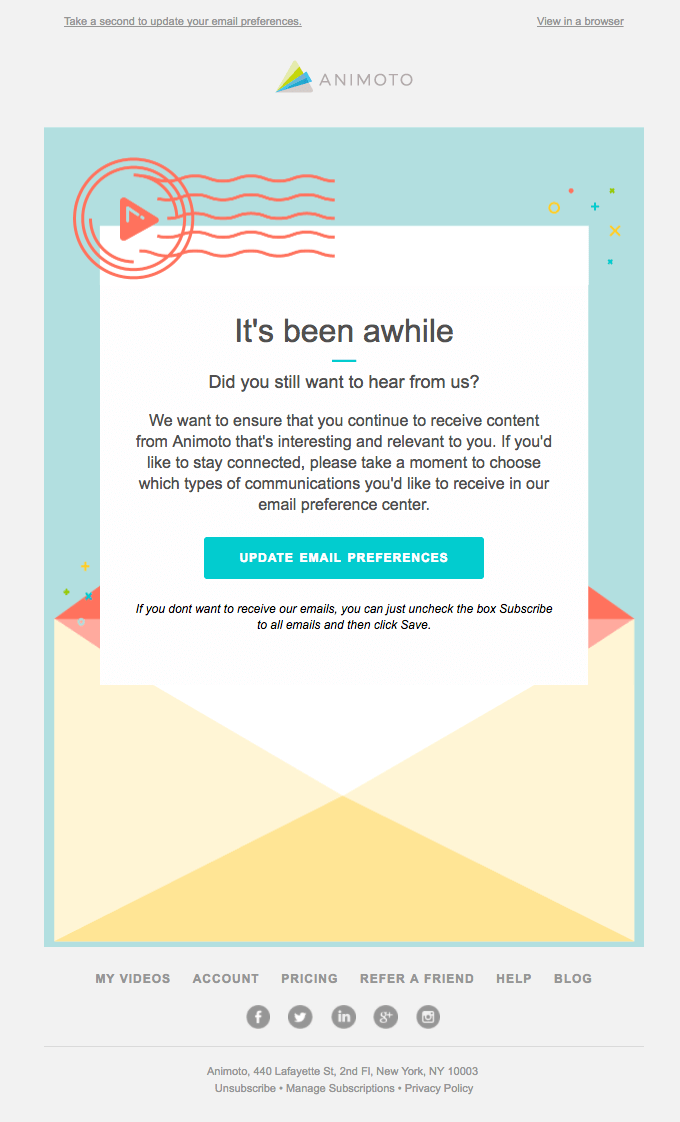
- Reminding subscribers why they signed up for the email is also important when asking them if they want to unsubscribe. According to MailerLite, customers might get distracted or turned off from all the emails they receive, thus reminding them what they signed up for in the first place is good practice. 9Clouds is one of the companies that does this.
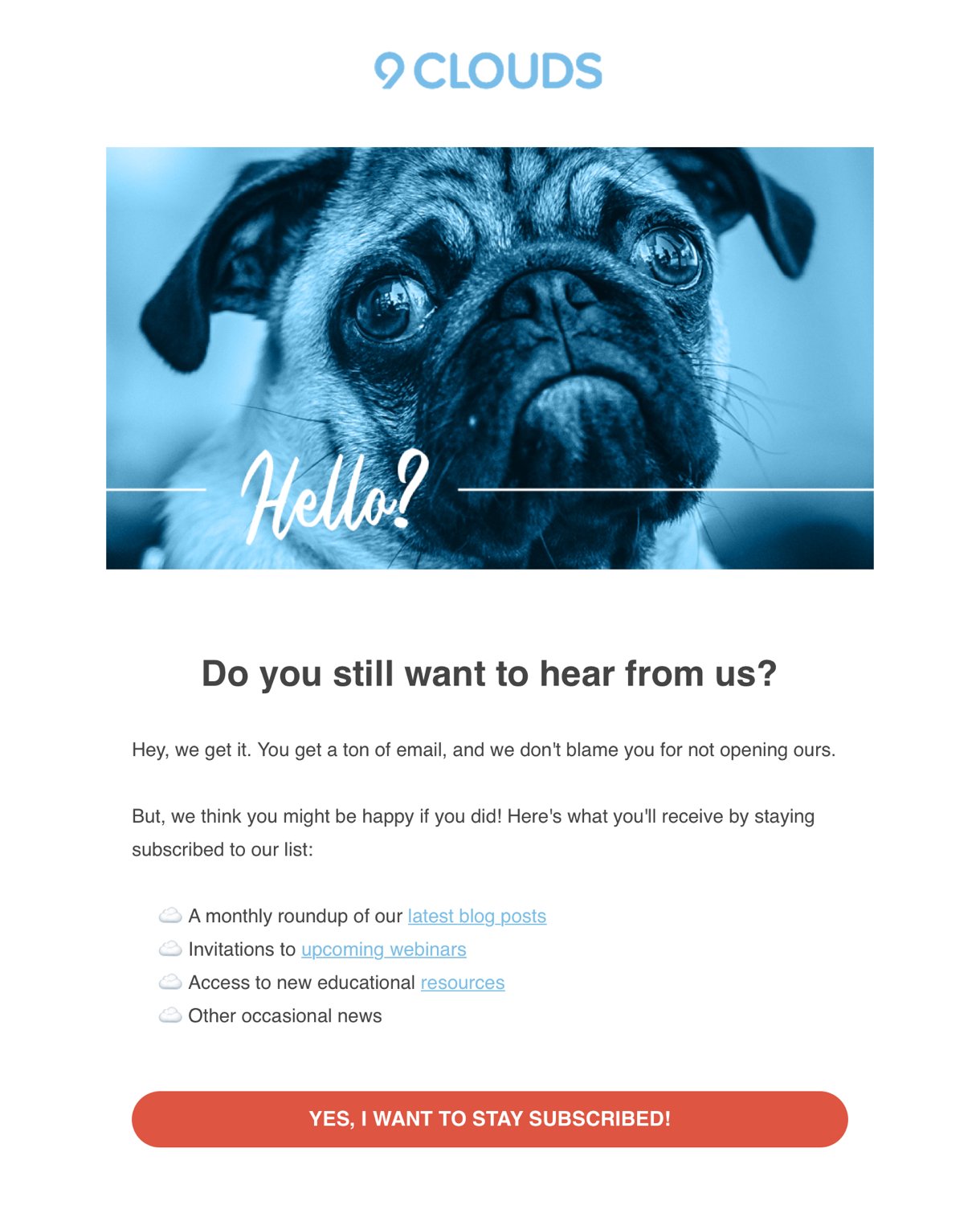
- However, asking customers whether they want to unsubscribe should not be the end of asking for specific feedback. A company can also ask its customers what they like to hear about, what they expect in terms of content, or the problems they might be facing among others. From the feedback, an organization will be better placed to personalize as well as send relevant content to its customers.
3. Give Customers A Choice
- Customers change with time and can sometimes lose interest in the type of content they receive from a company. Therefore, while giving them an option to unsubscribe is good, an organization can also provide them with several choices that will make them think more about whether they still want to unsubscribe.
- According to Litmus, it is possible for some subscribers to be open and engaging with webinars or ebook emails they receive from a company, but at the same time not be interested in its product updates or offers. Therefore, consumers should be offered choices and not just a “Unsubscribe or Bust” email.
- BirchBox was at position 3 on HubSpot’s list of 13 examples that companies should seek inspiration from when launching re-engagement email campaigns. According to HubSpot, BirchBox provides its customers with interesting and rewarding options to re-engage.

- Not On The High Street is also a good example when it comes to companies that provide their customers with choices and not just the unsubscribe option.
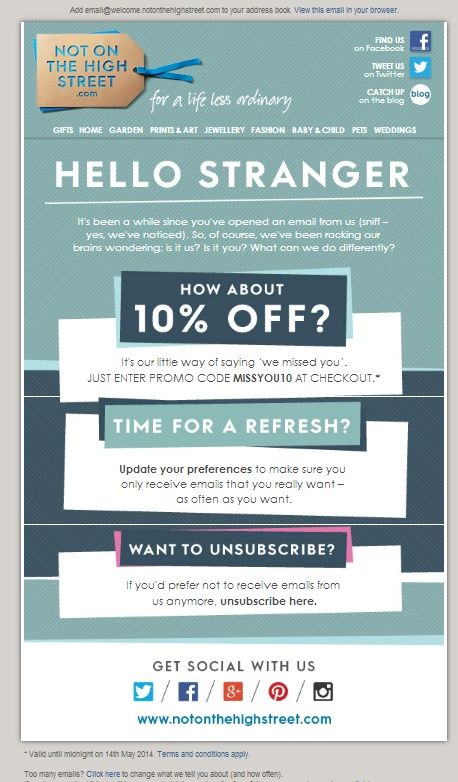
- Email Vendor also agrees that it is important for financial institutions such as banks to provide customers with choices as it is one of the best ways to meet and exceed their expectations.
4. Run Tests
- SuperOffice reported that it is best practice for an organization to run tests on the various email campaign elements it uses such as subject lines, personalization, messaging, and design among others. Testing the various elements is important because the business can use the data to make sound decisions that will improve its performance.
- According to Base, split or A/B testing involves “sending out two versions of an email with one crucial difference between the pair and then analyzing both to see which performs better,” and it is important because a company will know what to improve on.
- Some of the common email campaign elements usually tested include;
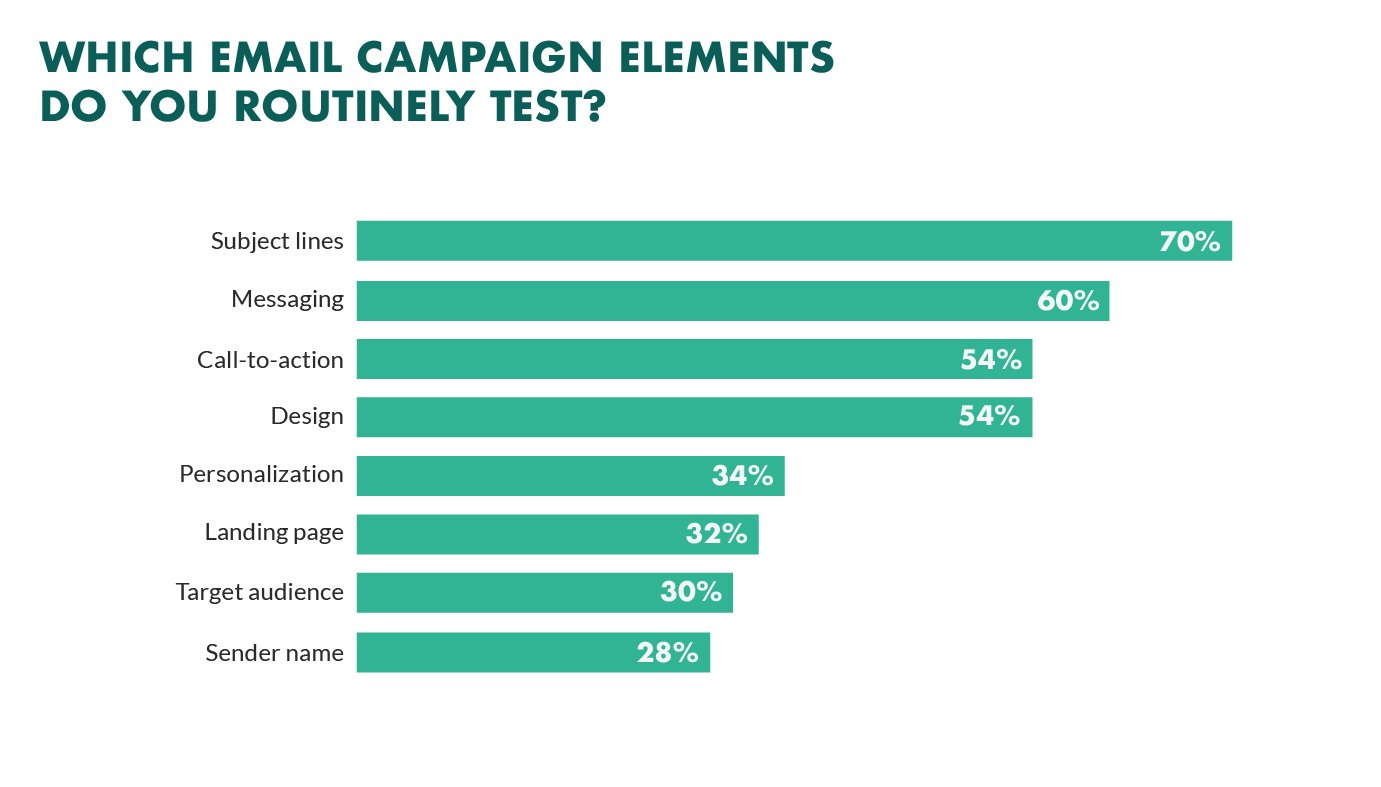
- Light Stalking is a good example of a company that ran tests on its email subject lines and was able to increase its web traffic. The company sent two identical versions of an email with the only difference being the subject lines. One of the emails had a straightforward subject line “The Weekly Challenge is Live!” while the other one had only one word that hinted at the type of challenge, “Silhouettes.” From the two, the “Silhouettes” subject line won after the “email yielded an above-average click-through rate, which drove more people to the Light Stalking website and increased overall engagement levels.” This in turn increased the company’s web traffic by 83%.
5. Timing is Everything
- According to Lexer, the duration of a prospecting or re-engagement email marketing campaign is important because if it is too long or short, the campaign will suffer. On one hand, a company that runs a long campaign risks experiencing the law of diminishing returns while on the other, a short campaign might cut short its reach and performance.
- Campaign Creators also reported that a re-engagement campaign should not be too long or short to avoid poor results. Thus, a “timeline of weeks or at most, a couple of months such as a 30-60-90 day scheme” is recommended.
- Lexer further stated that campaigns tailored to different seasons are more likely to perform better. Disney is a good example of companies that take advantage of the different seasons to send re-engagement emails. The company uses holiday nostalgia to win deactivated users back by sending them a re-engagement email with the right content at the right time.

6. Segmenting Subscribers
- By segmenting the subscribers that are in a company’s database, the company will be in a better position to send its customers the most relevant content possible.
- All customers are not the same which means that sending a generalized or broad message would not be as effective as sending each targeted email that focuses on their needs.
- Research by HubSpot found out that email marketing KPIs perform better when an organization segments its email list. The study further revealed that “39% of marketers who segmented their email lists experienced higher open rates, 28% experienced lower unsubscribe rates, and 24% experienced better deliverability and greater revenue.” More advantages of segmenting can be seen in the image below.
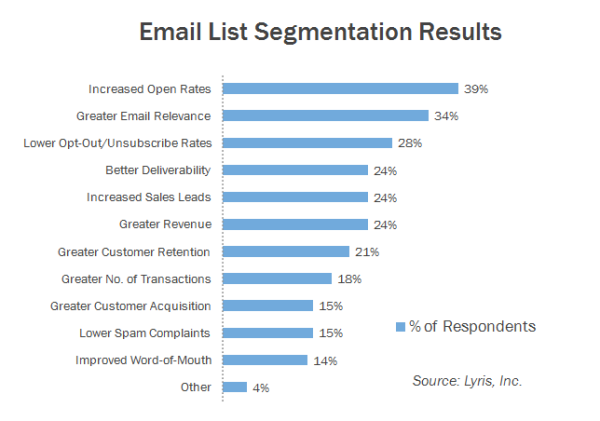
- Campaign Monitor advises that when segmenting inactive customers, a company should look into their recent activities, where they signed up such as on a landing page or a lead magnet, and their purchase history among others.
7. Personalizing Messages
- Research by Experian found out that personalizing emails can increase transaction rates up to 6x, while another recent research quoted by SuperOffice revealed that personalization can “generate $20 in ROI for every $1 invested.”
- One of the simplest forms of personalization is to address the customer by name and studies have found out that email subject lines that contain a recipient’s first name have the potential to increase open rates by 16% or even higher.
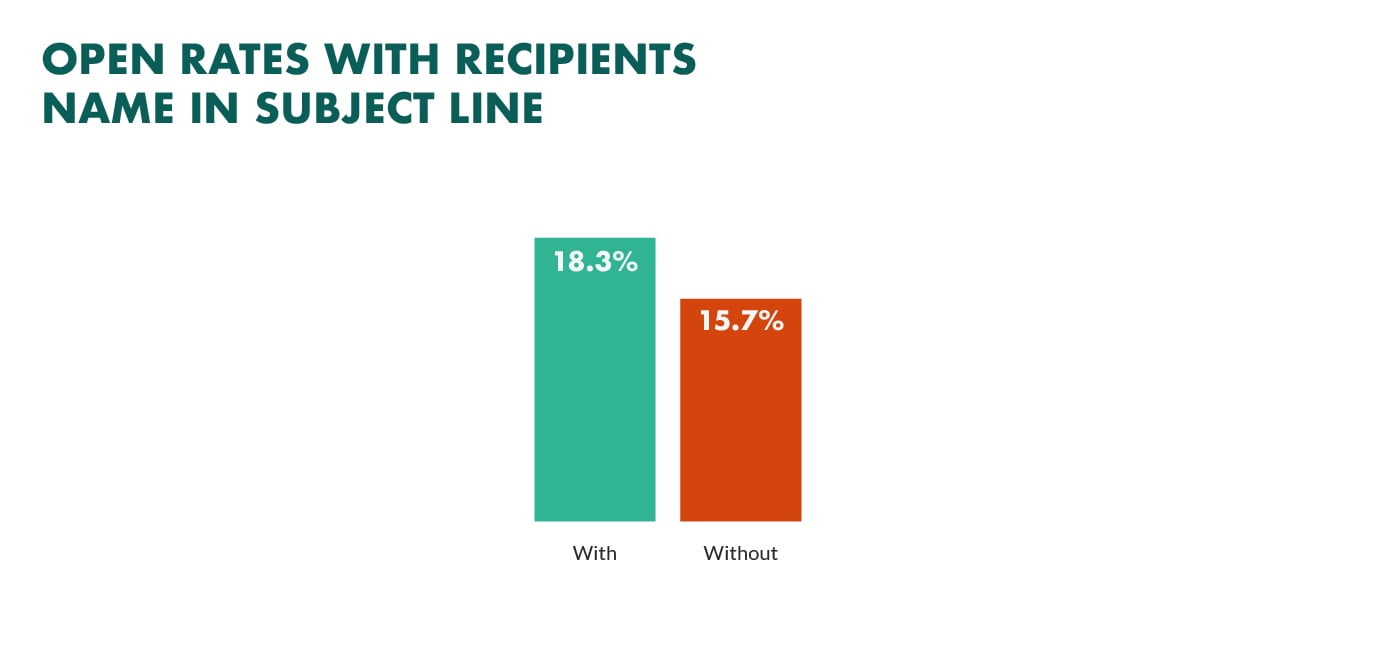
- Another research by Adobe found out that around 67% of customers expect personalized content and almost half of them get annoyed when companies fail to send them customized content. As a result, it is important for a company to personalize its emails and focus on its voice or tone to sound conversational or even casual, especially in re-engagement emails.
8. Segmenting Subscribers
- By segmenting the subscribers that are in a company’s database, the company will be in a better position to send its customers the most relevant content possible.
- All customers are not the same which means that sending a generalized or broad message would not be as effective as sending each targeted email that focuses on their needs.
- Research by HubSpot found out that email marketing KPIs perform better when an organization segments its email list. The study further revealed that “39% of marketers who segmented their email lists experienced higher open rates, 28% experienced lower unsubscribe rates, and 24% experienced better deliverability and greater revenue.”
- Campaign Monitor advises that when segmenting inactive customers, a company should look into their recent activities, where they signed up such as on a landing page or a lead magnet, and their purchase history among others.
9. Personalizing Messages
- Research by Experian found out that personalizing emails can increase transaction rates up to 6x while another recent research quoted by SuperOffice revealed that personalization can “generate $20 in ROI for every $1 invested.”
- One of the simplest forms of personalization is to address the customer by name and studies have found out that email subject lines that contain a recipient’s first name have the potential to increase open rates by 16% or even higher.
- Another research by Adobe found out that around 67% of customers expect personalized content and almost half of them get annoyed when companies fail to send them customized content. As a result, it is important for a company to personalize its emails and focus on its voice or tone to sound conversational or even casual especially in re-engagement emails.




